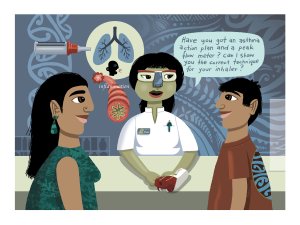Academic pharmacist Nataly Martini discusses the medical management of asthma in adults and adolescents, which has evolved to prioritise early anti-inflammatory treatment. She also explains how to improve patient outcomes by proactively identifying poor asthma control and supporting equitable access to education and treatment
Travellers asked to be alert for mumps symptoms
Travellers asked to be alert for mumps symptoms
Swollen salivary glands, headaches, fever and jaw pain are among the unpleasant symptoms of mumps that those who shared recent international flights with an infectious person should be alert for, following confirmation of a case.
Health New Zealand – Te Whatu Ora is asking anyone who was on recent flights from Chennai (India) on to Singapore, then from Singapore to Auckland to remain vigilant for mumps symptoms, after a New Zealander returning home on the same flights became unwell.
The person, who was diagnosed with mumps on Friday (22 March), has now recovered and was unaware that they were potentially infectious while travelling.
The flights shared by the mumps case were:
• 13 March 2024: Singapore Airlines flight SQ0529 from Chennai (India) to Singapore, departing at 11.15pm (IST), arriving at 5.28am (GMT+08).
• 14 March 2024: Singapore Airlines Flight SQ0281 from Singapore to Auckland, departing at 8.45 am, arriving at 11.35pm.
Anyone who was on the flights is asked to be on the lookout for symptoms, and if feeling unwell, to stay home and contact their healthcare provider, or call Healthline on 0800 611 116 for advice and support. If visiting a healthcare provider, please phone ahead so they can take steps to prevent themselves and others from getting infected.
“Mumps is caused by a virus that spreads very easily between people. The initial symptoms of mumps, such as fever, headache and tiredness, are similar to many other illnesses. Pain, swelling and tenderness (sore to touch) of the cheek and jaw area develop a few days after the other symptoms,” says National Public Health Service Clinical Director, Dr Susan Jack.
“It can take anywhere from 12 – 25 days after contact with someone who has mumps to develop symptoms. This means that anyone who travelled on the same international flights as the case could start to develop symptoms any time from now, through until about the 8th of April, so it’s important to stay vigilant.”
Mumps spreads through the air by talking, breathing, coughing and sneezing. It can also spread through saliva, for example by kissing or sharing food and drinks. You can easily give mumps to someone else from two days before swelling appears, until five days after swelling starts. People who have the infection but do not have symptoms can also spread mumps.
“The best form of defence against mumps is to be immunised with two doses of the Measles, Mumps and Rubella (MMR) vaccine. So, it’s really important that people make sure they’re up to date with their immunisations, particularly when travelling. The good news is that the MMR vaccine will also protect you from measles and rubella.”
Vaccination sites can be found by visiting: Immunisation • Healthpoint
More information about mumps symptoms and the recent case locations of interest can be found here: https://info.health.nz/conditions-treatments/infectious-diseases/mumps/





